Londoners, says the Daily Mail, will presently be able to witness a striking object lesson, which, if turned to proper account, might be the means of suppressing the hooligans who infest certain London districts. A remarkable troupe of Japanese performers having arrived for the purpose of exhibiting their skill at the Alhambra. Smiling Japan used to possess hooligans as desperate and as defiant as any of those in the metropolis, but Japan has a means of dealing with them.
The three men who are to perform at the Alhambra are champions in the art of “jujitsu,” and are pupils of the celebrated Jigoro Kano, ex-director of the higher normal school of Japan. He is the founder of the system, and has established schools where the art is taught, his ambitions and object being that the better (and unathletic) classes of Japan may be able to give a good account of themselves, if molested by muscular ruffians, either abroad or at home, and thus maintain the reputation of the old samurai or fighting class of Japanese feudal times.
Jujitsu, literally translated, means ‘fighting to the last,’ and an opponent is never considered beaten until he holds up his hand as a token of defeat.
In jujitsu, ground wrestling with the legs (and not with the arms as in European wrestling), plays a very important part. Strictly speaking, however, the art is as entirely different from wrestling as is boxing. If a man fall in jujitsu, it is not because he is thrown by his opponent, but because he throws himself, either to escape worse injury, or else to gain an advantage.
To know jujitsu is to have learnt the science of breaking a man’s bones, straining his muscles, or killing him in a hundred different ways without leaving a mark on his body. Its principle is simply that of attacking the point of least resistance, and then, using with small exertion, the different parts of the body as levers, to retain one’s own gravity and destroy that of your opponent. When a man is down, it is not only necessary to keep him down, but to hold him in such a way that every bone in his body can be broken if he dares to move. To do this, the man who is beaten may at the time be lying on his face, side, back, or even on the top of one, and yet be held in such a position that it is impossible for him to move an inch.
Many of the holds have only to do with the clothing, and it is just as possible to choke a man to death with his own coat collar, or to break his arm while holding the sleeve of his coat, as it is to accomplish the same thing by actually grasping him himself.
This is the first time that exponents of jujitsu have been allowed to leave Japan, to demonstrate the system publicly”
–The Japan Times, Friday, Nomber 30th ,1900 (Meiji 33)
With the victory of Royce Gracie in the first UFC in 1993, the martial arts community has been asking a question: where does Gracie jiujitsu come from. Until recently, the most common response in Brazil was that jiujitsu was created by Buddhist monks in India. That response was never satisfactory, however, as its Japanese roots are evident in everything from its name to the clothes practitioners wear during a tournament. Even though it might seem complex, the history of jiujitsu in Brazil is actually little different from similar styles that appeared in many countries around the world when judo started to spread outside of Japan.
The word jiujitsu (or jujutsu, using the current Romanization system) is not the name of a single Japanese martial art; rather, it is a generic term used by a number of martial traditions (ryu) that developed over many centuries in Japan. In 1882, Kano Jigoro, after studying two different schools of this art, Tenjin Shinyo-ryu and Kito-ryu, founded his own dojo called Kodokan. Through this amalgamation of knowledge from different schools, he created what is known nowadays as judo.
Contrary to what is popularly believed in the West, the term judo was not invented by Kano Jigoro, as it was already used in 1724 by Inoue Jibudayu of the Jikishin-ryu, and possibly even before that by other jujutsu exponents. Meiji-period books quite often use the term judo as a synonym for jujutsu, referring to certain jujutsu schools as judo schools. However, this use probably only occurred after the term was popularized by Kano. Thus, when referring to Kano Jigoro’s judo, I prefer to use the name given by the spiritual source of the discipline—that is, Kodokan Judo. Kano’s judo was sometimes also called “Kano Jujutsu” or “Kano-ryu Jujutsu.” The system that he originally devised, deriving it from various sources (two of the main ones being the Kito-ryu and Tenjin Shinyo-ryu), was still very close to the jujutsu of the Edo period, and completely different from what we now see in modern judo or judo competitions.
-Serge Mol, Classical Fighting Arts of Japan: A Complete Guide to Koryu Jujutsu, 2001
In the early 1900s, when a large number of martial artists began to emigrate from Japan to the West, the words judo and jiujitsu were interchangeable. There was certainly no distinction between the two terms outside of Japan, and the difference between judo and jujutsu was poorly understood, even for the Japanese.
One of the most significant of the judoka who took the art outside of Japan was Maeda Mitsuyo. Maeda, the putative founder of Brazilian jiujitsu, was born in 1878. He competed in sumo in his youth, and enrolled in the Kodokan in 1897. Maeda ascended to the rank of third dan in 1901 and began teaching judo at the Gakushuin (the Army Cadet School), as well as other institutions. He distinguished himself even within the Kodokan. This is shown by the fact that the four leading disciples directly instructed by Kano Jigoro were called Kodokan Shitenno (Four Guardians of the Kodokan). Maeda became known as one of the Kodokan Sanba Garasu (Three Pillars of the Kodokan), along with Todoroki Shota and Samura Kaichiro as the next generation leaders.
Tomita Tsunejiro 6th Dan, Maeda Mitsuyo 4th Dan
After leaving Japan in 1904, Maeda, like every other Japanese martial artist had to adapt to Western culture. Differing from Japan, where judo’s challenge matches against jujutsu lowered interest in the latter, the West was eager to understand Japanese martial arts as a form of combat. The main employer of Japanese martial artists were law enforcement agencies, and there were no judo tournaments as were practiced in Japan. Maeda had to fight in competitions with rules very different from those of the Kodokan to prove the efficiency of the Japanese martial art. As Westerners were not used to the ceremonial form of kata practiced by the Japanese, techniques were taught in a less structured way. As the ‘self-defense tricks of jujutsu’ became popular, many books were published in which is hard to tell from which ryu each technique might have been taken.
As judo fighters had also to adapt to fight in different venues such as ‘catch as catch can’ wrestling, it also affected the method in which judo would be taught, as people in the West were mostly interested on the fighting aspect. To be sure, there were many judoka who came up with their own ideas of what judo should be after the Kodokan was created. Some even created their own set of kata. Without the rigid control of Kano and the Kodokan outside of Japan, Japanese instructors had all the freedom they needed to create their own methods of teaching.
Maeda Mitsuyo and Ono Akitaro, Subtitle: Catch as Catch Can Ryu (カッチアズ、カッチカン流) Shinjudo Musha Shugyo: Sekai Okou Dai Ni, Maeda Mistuyo, Usuda Zan’un, 1912
The first contact the West had with jujutsu—apart perhaps from the occasional sailor who received a demonstration for some transgression committed while on leave in a Japanese port, or the diplomats, journalists, and adventurers who were living in japan just prior to the Meiji reform and had opportunity to see jujutsu performed as a part of official government ceremonies—was thanks to Japanese expatriates working overseas at the end of the nineteenth and early twentieth centuries. These expatriates were by no means jujutsu ‘masters,’ and their rather limited jujutsu knowledge (though it was impressive enough to draw the attention of the contemporary Westerner to jujutsu) was mainly borrowed from systems such as the Tenjin Shinyo Ryu, the Yoshin Ryu, and of course Kano Jigoro’s judo (itself a product of the Meiji period).
-Serge Mol, Classical Fighting Arts of Japan: A Complete Guide to Koryu Jujutsu, 2001
To understand how Brazilian jiujitsu was in the beginning, we can compare it to the many other judo or jujutsu schools that were created around the same time in the West. The ‘jiujitsu movement’ happened on a global scale, verified by the many books that were published throughout the world, using such names as judo, jiujitsu, jujutsu or jujitsu. This video of the London Budokwai with Gunji Koizumi from 1949 represents this quite well, as the self-defense moves of the Budokwai Goshinjutsu in many ways resemble the self-defense method taught by the Gracies from the old days until now:
The Gracies
It is the instructor of our police – the first national organization that adopted this method of defense – Mr. Carlos Gracie, a young man born in Pará, that since March last year has been doing such work.
–Diário Nacional 1929 (newspaper)
Maeda has a main role in the development of jiujitsu in Brazil, not only for allegedly being the first teacher of Carlos Gracie, but also because the main two lines of jiujitsu still surviving in Brazil (Fadda and Gracie) are connected to him.
Maeda arrived in Brazil in November, 1914, along with other well-known judoka such as Ito Tokugoro , Uyenishi Sadakazu, Ono Akitaro and Satake Soshihiro. Upon arrival, all members of that small entourage held fights in Brazilian territory, and they and other Japanese continued this for over a decade and a half. It was not until early 1930’s, however, that jiujitsu schools began to attract more attention from the population at large, as opposed merely to the professional fight circuit, and then, mostly in the capital, Rio de Janeiro.
One of the first appearances of Carlos Gracie by a Brazilian newspaper regarding Jiujitsu occurs in 1929, where he talks about his recruitment by the police of Minas Gerais. Carlos explains his rise in the sport:
“I learned Jiujitsu in my hometown, Pará, where there passed a Japanese troupe in which was part the famous Count Maeda Koma, instructor of Japan’s Imperial College.”
This Maeda Koma, who had been the teacher of Carlos Gracie, had been in Belo Horizonte years ago, probably with the same troupe, and conducted an interesting and unexpected demonstration of his strength and agility in the old Cinema Comércio.
–Diário Nacional 1929
In 1930, after fighting with Geo Omori, a Japanese fighter already well known to the Brazilian public, Carlos became instructor at Academia de Jiujitsu do Rio (later to become the Gracie Academy), founded by Donato Pires dos Reis. Donato had previously brought Carlos to work as his assistant with the police of Minas Gerais. He was a former student of Maeda in Pará and would state, years later, that Carlos never met Maeda. Furthermore, he claimed that he was one of the few individuals recognized by the master as an instructor, as evidenced by a diploma he showed to journalists.
Whatever the merits of his claim, Carlos could hardly have been a long-term direct student of Maeda. According to the standard account, Carlos started his apprenticeship at 14 years old. At that time, however, Maeda was not fully established in Brazil; rather, he had been traveling in-and-out of the country. When he finally settled down, the Gracies had already moved away from Belém do Pará. Furthermore, Maeda, by that time, was mostly interested in helping the establishment of the Japanese immigrants rather than teaching judo.
We do have a near contemporary account that is contrary to the standard myth: according to José Brigido in the Diario de Noticias newspaper in 1932, the Gracie brothers learned jiujitsu from Donato Pires. Whatever Carlos might have learned at the academy of Maeda, it would have been a short time, at best, and it most likely came from classes with Jacyntho Ferro, the school instructor. Did Carlos have enough time studying in Maeda’s academy to have learned enough to teach all his brothers, and build them into ring fighters? Or did he continue to pick up knowledge elsewhere? Whatever the facts, Maeda was highly popular in Brazil, considered the greatest master of jiujitsu in the country, and to be connected to him would give anyone credibility.
Carlos started to get the attention of people as a jiujitsu instructor after his fight against Geo Omori. According to Geo Omori, the young Gracie did not know anything but self-defense tricks before the two met. George Gracie would make an statement later that he also studied with Omori, as Carlos knew only self-defense. Geo Omori apparently taught Carlos ‘jiujitsu for the ring.’ Whether Omori taught Carlos as a teacher, or did so more informally, such exchanges between jiujitsu fighters were frequent, not only among the Gracies, but also among the Japanese who have become recognized in that period.
It must be understood that jiujitsu was not the only martial sport flourishing in Brazil. There was also luta livre, Brazil’s form of ‘catch as catch can’ wrestling. Even today, Brazil currently has both Brazilian jiujitsu academies and Brazilian luta livre, both arts being regarded as national sports. There were a lot of exchanges between jiujitsu fighters and luta livre fighters throughout their history. Carlos, however, was focused on trying set up the family as the pioneers of jiujitsu in Brazil; therefore, he tried to maintain the appearance of a certain distance outside influences on his own jiujitsu. Brothers Oswaldo and George, on the other hand, freely trained with many different fighters, without hiding it whatsoever. In 1932 Orlando Americo da Silva, also known as Dudu, assisted in the training of George Gracie to fight catch as catch can wrestler, Fred Ebert. Dudú also trained at the academy in Marquez de Abrantes. In January of 1933 during a training session at the Gracie Academy, Dudu broke Oswaldo Gracie’s leg in three parts. George would later fight against Dudú in the ring.
I sincerely appreciate the great interest of my brother Carlos, when manifested his fear for my first setback, but I wanna say to him that this will not happen, I will match the confidence of those who know me closely. Since I left Rio I was in great shape and now reached my best condition thanks to the dedication of my head coach Dudu.
-George Gracie in Jornal dos sports, 1932
Euclydes Hatem, also known as Tatu, considered the founder of Brazilian Luta Livre and one of its main representatives (center). At the right, Oswaldo Gracie.
In 1939, George Gracie united with Donato Pires to open a new academy in Rio de Janeiro. To give even more credence to the hypothesis that Carlos may have learned only self-defense with Donato and ring-fighting with Omori, Donato was responsible only for the curriculum of self-defense, while George taught jiujitsu for the ring. This venture didn’t last very long, as George was more interested into fighting than teaching. Perhaps that is why Carlos and Helio’s affiliates became more widespread throughout Brazil today, while George’s lineage in jiujitsu is almost lost.
Helio started to be part of Carlos’ academy of jiujitsu in 1931. Wanting to be independent from Carlos, their other brothers decided to leave the academy and set up their own businesses. As Carlos assumed the role of manager of the Gracie Academy, Helio became both the head instructor and the leading fighter. Even so, it would be common for the brothers to unite into training, especially before fights. By 1937 the biggest names of jiujitsu in the media disputing the title of champion of jiujitsu were Helio and George Gracie, Geo Omori, Yano Takeo (who was a member of the famed Yano family of Kyushu, the founders of Takenouchi Santo-ryu), and the Ono Brothers. The Japanese were all Kodokan Judo trained. There were actually many more judo representatives, in places like São Paulo for example, but they mostly trained within the Japanese community. The Japanese tended to form closed communities with little communication with outsiders. The Brazilian government would eventually see that as a problem, as the Japanese population in Brazil increased and, instead of trying to interact with the locals, they decided to form what would resemble entire Japanese cities inside of Brazil.
Brazilian Jiujitsu Lineage Chart – Created by Christiano Martins Milfont – Note the clear evidence of mutual exchanges, back-and-forth between Japanese and Brazilian practitioners
In 1938, Helio Gracie and George Gracie disputed the title of the best jiujitsu fighter throughout the media. George had been the main coach for many of Helio’s fights, as well as his sparring partner, and now the press was pressuring the two to decide who was the best in a bout. Members of the same family, however, they would never fight. As George went to the newspapers, saying that the dispute had to happen, the two brothers became more distant. Helio decided to retire because, according to him, he could no longer find any worthy opponents. Helio’s retirement lasted around ten years. During this time, however, George kept on fighting.
Diario da Noite, September 1938, “A Title That Has to be Put on the Line:” It is for the Brazilian boxing federation to determine who is the national champion of jiujitsu – the anomalous situation of brothers George and Helio Gracie
During this period, a little known fact almost changed the course of jiujitsu history in Brazil—Helio got involved with judo. In 1939, Helio participated in the 7th championship of the Jukendo Association, the first Judo and Kendo association to be created in Brazil (NOTE: the name is not related to the Japanese martial sport of bayonet fighting, also known as ‘jukendo’) This event also had the presence of two Kodokan official representatives.
[..]As is from the knowledge of our readers, the only Brazilian who intervened on the seventh Jukendo Association Championship was the young and already established fighter Helio Gracie. The Brazilian champion also had the opportunity to measure up with Sato and Kotani. Opining on the value of both teachers he said:
“In my life I have met strong and agile fighters but their methods of fighting didn’t worry me. But in relation to black belts Sato and Kotani, I find no superlatives to define their classes and expertise. What impressed me most was undoubtedly the firmness with which they did the takedowns and the elegant way they treated their opponents. They are perfect gentleman, worthy of the honorable mission entrusted to them by the government of Japan.” Also said Helio: “Since I stopped fighting in public as a professional, I always fed the desire to participate in the amateur category in the championships of Jukendo, which is why I decided to sign up for the seventh championship held Sunday, while not knowing almost completely its regulations. So I could not, as it was my wish, to compete with freedom of movement by the fear of incurring an illegal technique.”
-Correio Paulistano, August 1939, article title: The difference between judo and Jiu-Jitsu
This official Kodokan delegation was headed by Kotani Sumiyuki. By that time, the word jiujitsu was widely spread, and Kotani’s task in Brazil was to solve the confusion that was taking over the country: What’s the difference between judo and jiujitsu? Most people believed that judo was only primarily stand-up grappling. Not only that, many masters in Brazil by that time presented judo with the name jiujitsu. By that time, Helio Gracie was already a famous fighter inside the Japanese community, after the fights he had with some Japanese fighters. He was invited to give presentations on judo together with the Kodokan representatives. According to Pedro Valente Jr. he was awarded a Kodokan Judo Black Belt from Kotani.
They knew of Grand Master Helio’s great success and his amazing victories against Black Belts from Japan, famous black belts from Japan including Taro Miyake, and so they decided to award him a black belt, and to say that from now on he should call this judo not Jiujitsu, and he should abide by this new rules for sportive competition. And at that time, Carlos Gracie was in Ceara, in the northeast. Immediately when he found out he talked to his brother and they both agreed that they should not follow the Japanese system, and they never actually wore that belt that was awarded by the highest authority at that time. Kotani was coming as an emissary of the Japanese government, so it was an official government trip. But the Gracie brothers did not accept. They were respectful, demonstrated appreciation for the recognition, but they wanted to continue to teach jiujitsu as an art of self-defense and not abided by those Japanese rules. (Editor’s note: According to the linked Wikipedia notes, Gracie most likely defeated another individual with the name Miyake, as the famed wrestler Taro Miyake, never set foot in Brazil).
Kotani did presentations, visited judo masters and tried to convince them to subscribe to the Kodokan rules. São Paulo, as an important state in Brazil and one of the main centers of Japanese immigration, was the main place of residence of most of the Japanese judoka. Because of that, the state became the main stage of the judo vs jiujitsu movement. This started a rivalry that would persist for some years, it was known as “the Kodokan vs Ogawa and the Ono brothers rivalry”.
In addition to the Japanese groups’ disagreement, there were the Gracies. The Gracies were the main, if not the only, group of jiujitsu teachers not connected to any Japanese master. Even though Carlos and Helio shared knowledge with many people throughout many years, they would never acknowledge anyone but Maeda Mitsuyo as the source of their techniques. However, even though Maeda was still alive after the Gracie Academy began operation, Carlos never met Maeda again (unlike Geo Omori and Yano Takeo). If Carlos had, in fact, met Maeda in his early jiujitsu journey, his connection with Maeda was broken right after he left Pará.
During Helio’s retirement, the Gracie Academy was closed. Carlos moved to various different states, and Carlos and Helio were not on the front cover of newspapers as much as they were before. In the beginning of 1950, Helio decided to end his long retirement. By that time, he was only teaching a few students at his residence in Rio. Judo was gaining increasing popularity, especially because its students, different from jiujitsu schools, could participate in amateur tournaments. The jiujitsu community started to ask for more competitions for ordinary students, as opposed to the challenge matches in which those considered professionals fought for prize money.
The Separation of Judo and Jiujitsu
As is well-known, Helio Gracie gained a lot of visibility in the media after his fights against Kato Yukio and Kimura Masahiko. This enabled Carlos and Helio once again open the Gracie Academy, regaining some of their notoriety, but even so, jiu-Jitsu continued to lose popularity to judo.
Kimura Masahiko & Helio Gracie
In October, 1952, a new group from the Kodokan went to Brazil, comprised of Takagaki Shinzo, 8th dan, Yoshimatsu Yoshihiko, 7th dan, and Osawa Yoshimi, 5th dan. Once again, this group of Kodokan representatives hoped to unite all the judo practitioners in Brazil. Despite the creation of the Jukendo Association in São Paulo, Brazil still didn’t have a judo federation, even though the organization of tournaments was growing little by little. Osawa fought against 15 judoka from the Budokan Academy, headed by Ogawa Ryuzo, and won all the matches. This competition was called A Grande Competição Brasileira de judo and involved the São Paulo State Sports Department and the General Consulate of Japan. Also participated in the event the Academies of Ono, Jaraguá, Taipas, Jabaquara, Naito, Esporte Clube Pinheiros and Yoshima.
Jiu-jitsu started to try to get organized during the same period. The first amateur tournament of jiu-Jitsu of Rio was held 1950, with the participation of the academies Gracie, Cordeiro, Natação and Maia. The biggest rival of the Gracie Academy among them was Augusto Cordeiro’s gym. Also participated in this competition was Oswaldo Fadda, who had just opened his academy in Bento Ribeiro, Rio de Janeiro state. Cordeiro, however, became more and more involved with judo during subsequent years, becoming a student of Ogawa Ryuzo. He would later would go to Japan to study at the Kodokan. As Cordeiro began to accept matches only according to judo rules, Oswaldo Fadda’s academy became the main antagonist of the Gracies, the rivalry became more evident after an event in which the Gracie students won seven matches, drew four and lost three against Fadda’s academy. Nonetheless, jiujitsu was struggling.
Today only two to three places do jiu-jitsu in Brazil. For long it is an outdated sport, and with no reason to exist. Even in Japan with the appearance of Kodokan it ceased to exist, thus proving its inefficiency. […] While Jiujitsu ended up almost disappearing, judo is gaining new followers. Such is the evolution of the sport that, when we can give the ideal organization that it deserves, Brazil will be the second best in the world second only to Japan.”
-Augusto Cordeiro for Diário da Noite newspaper, December 1957
In 1956 Kihara Yoshio, 7th dan, arrived in Brazil with the mission of drawing a clear line that would separate judo from Brazilian jiujitsu. After tournaments using the Japanese rules started to grow in Brazil, the next step was the introduction of the Kodokan kata. As there was no standard teaching methodology between the judo schools, the Nage no Kata and also the other kata of the Kodokan were not known by most of judo Instructors. The upcoming first judo World Championship in 1956 was the final piece to attract many of the judo masters to the idea of uniting all the academies into one federation.
At this time, Kihara sensei received from the Kodokan the task of teaching the nage-no-kata which until then was almost unknown among us. At that time, there was not yet a distinction between judo and jiujitsu. It was his responsibility to make a clear and final division between these two modalities. He thus established the consolidation of judo. However, we can state that this separation continued to be opposed by some entities who wanted to maintain the current status quo; in particular because they did not want to subordinate themselves to the Kodokan. Among them were the teachers Ogawa, Terazaki and Ono, who preferred to remain independent.”
-Stanley Virgílio, Personagens e Histórias do Judô Brasileiro, 2002
In 1958 São Paulo’s Judo Federation was founded, the first judo federation in Brazil. After that, Rio’s Federation started in 1962 and 1969 the first national Judo confederation was born. With that, Brazilian judo started to take the form it already had around the world, using Japanese rules and the teaching of the Kodokan kata.
By the end of the 1950’s, jiujitsu and judo had become two completely different entities. As the Gracie’s realized that jiujitsu was starting to lose its popularity to judo, the founding of a jiujitsu federation was inevitable. On July 12th, 1973, after six years of struggle, Helio and Carlos Gracie finally received from Jeronimo Bastos, president of Brazil’s National Sports Confederation, the official charter document to run the ‘Federacão Carioca de Jiujitsu,’ based on Rua Rodrigo Silva, 18. From that day on, both styles went their separate ways. In time, all surviving lineages of jiujitsu were incorporated into the Gracie federation, and nowadays in Brazil, most academies follow the Gracie lineage. Oswaldo Fadda participated in both judo and jiujitsu, but as he was involved with the Federação de Pugilismo that kept on allowing challenge matches (something forbidden by the Kodokan representatives), Fadda stayed as another survivor in Brazilian jiujitsu history, becoming part of the Gracie’s federation.
Jiujitsu Gets Federation After Six Years of Struggle
The only source of ‘Brazilian jiu-jitsu’ were Carlos’ classes with Mitsuyo Maeda. Maeda is recognized as a member of the Kodokan, and even been graduated ‘post-mortem’ by the Kodokan; however it is our understanding that the Gracie family have developed a method of teaching and rules specific to competition different from today’s Kodokan judo rules. In addition, as the Gracies began to disclose their method before the so-called Japanese period, when immigration brought some of the more prominent Brazilian judo teachers, their disciples spread across the country disseminating their school ( “ryu”) before judo consolidated. Therefore, Gracie jiu-jitsu representatives eventually contributed to the beginning of judo practice in some Brazilian states. Just like some practitioners of judo migrated to Brazilian jiu -jitsu in the decades of 1980 and 1990, in the 1950s and 1960s, some practitioners of Brazilian jiu -jitsu, taking advantage of the phenomenon of ‘sportivization,’ migrated to judo and were precursors of judo in places where the Japanese colonization had not much influence in society. For this reason, Carlos Gracie can be regarded as one of the ancestors of Brazilian judo, because from them descended some of the teachers that contributed to the formation of Brazilian athletes that were medalists in world championships and participants of the Olympic games.”
– Alexandre Velly NUNES, Kátia RUBIO, As origens do judô brasileiro: a árvore genealógica dos medalhistas olímpicos, 2012
Many more details and nuances can be incorporated into a text that talks about the history of Brazilian jiujitsu. Many people were influential throughout this process, which has lasted over 80 years and continues to be rewritten every day. Drawing a complete picture of the whole story is not possible in a single article, perhaps not even in a single book. The second generation of the Gracie family came, and just like the first Gracie brothers, continued to shape and update the art through time. Even today when we see the advancement of sportive Brazilian jiujitsu at the expense of self-defense, the Gracie family emerges as the fulcrum that kept the roots of Brazilian jiujitsu alive, an art that came from Maeda of the Kodokan, but found its own destiny.
Carlos & George Gracie training 1933 (left), Rolls & Carlson Gracie training in late 1960’s (right)
With the growth of Brazilian jiujitsu around the world, many of the dormant lineages seem to want to return to the surface and take their space and history back. However, what we mostly see is a historical fight for the protagonism of the art. Many criticized then, and criticize now the way the Gracies treated other martial arts academies, other martial artists, and their marketing. Some would even go further, saying that the Gracies are a terrible example for what jiujitsu stands for. However, if not for the Gracie brothers vision to create a family of fighters, as well as their stubborn independence and belief that they had the best fighting system of the world, perhaps Brazilian jiujitsu and judo would be one and the same today. In that case, they would have merely been one of many judo academies in Brazil. Instead, they became the family that showcased to the world the effectiveness of jiujitsu against other fighting systems through Vale Tudo, changing martial arts throughout the world.
Helio Vigio, (l), Helio Gracie (c) and Oswaldo Fadda (r) together in a belt graduation event of the federation founded by the Gracies
Author
Gustavo Goulart Braga Maçaneiro, Brazilian Jiu Jitsu 4th degree Brown Belt, Degree in Physical Education from Universidade Federal de Santa Catarina. Author of “From Judo to Gracie Jiu-Jitsu: The influence of Kodokan Judo in the idealization and development of Brazilian jiu-jitsu,” 2012 (graduate thesis).
No part of this material may be reproduced in any form or by any means, electronic or mechanical, including photocopy, without permission in writing from the author. However, you are welcome to share a link to this article on such social media as Facebook, LinkedIn or Twitter.

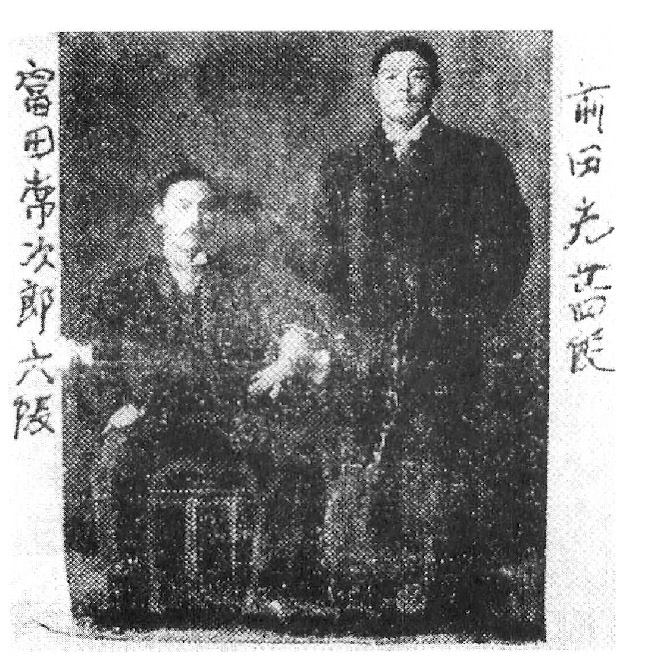
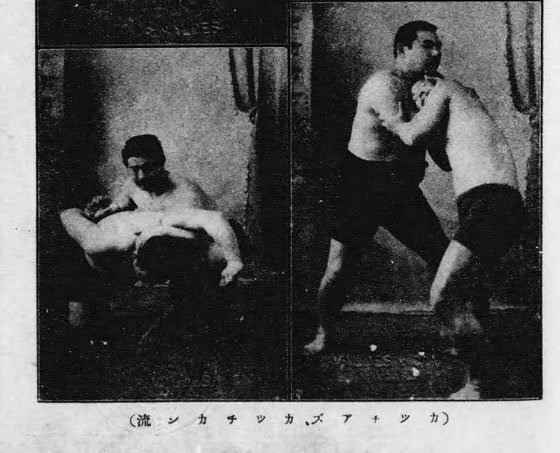
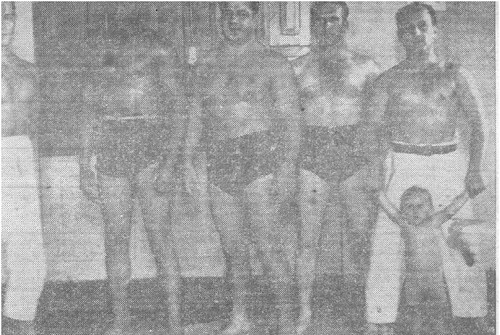
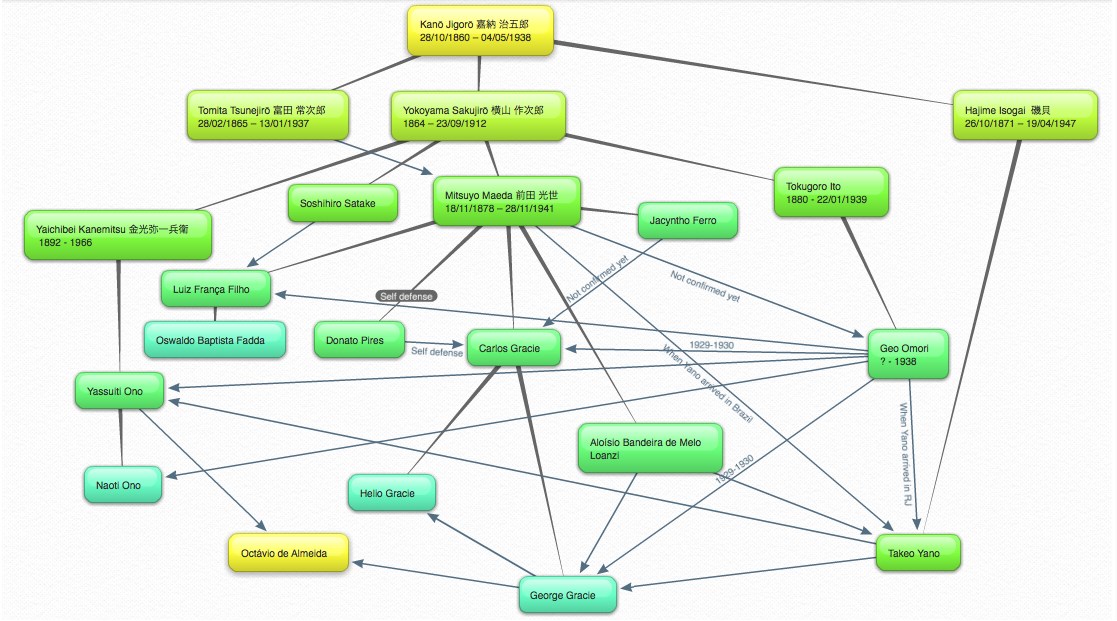

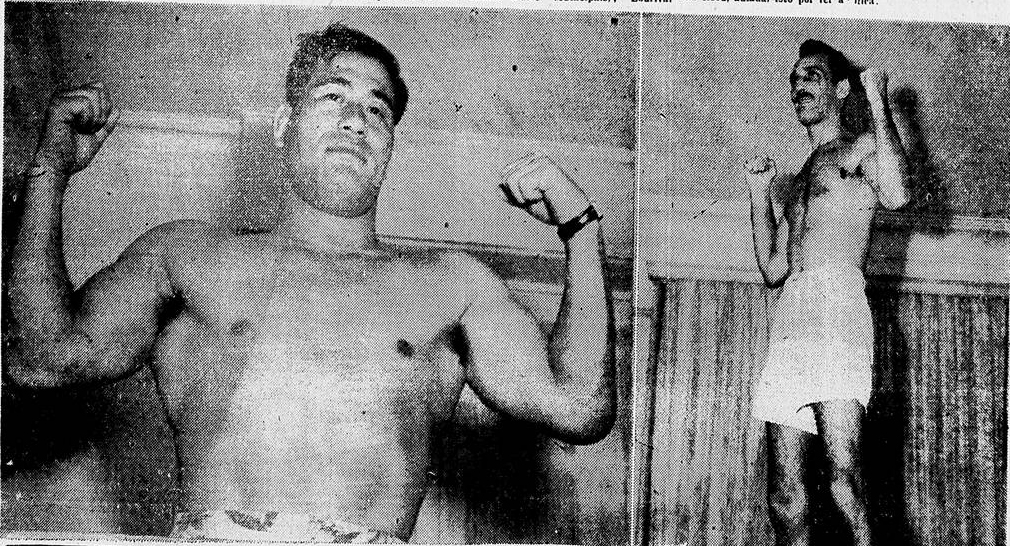

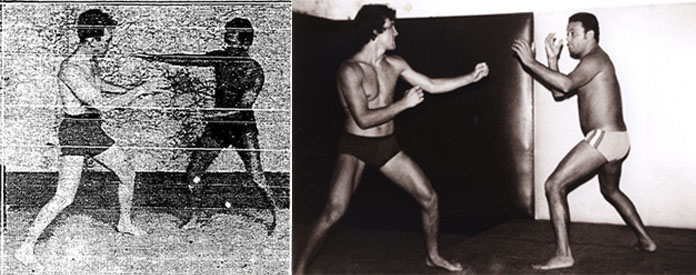
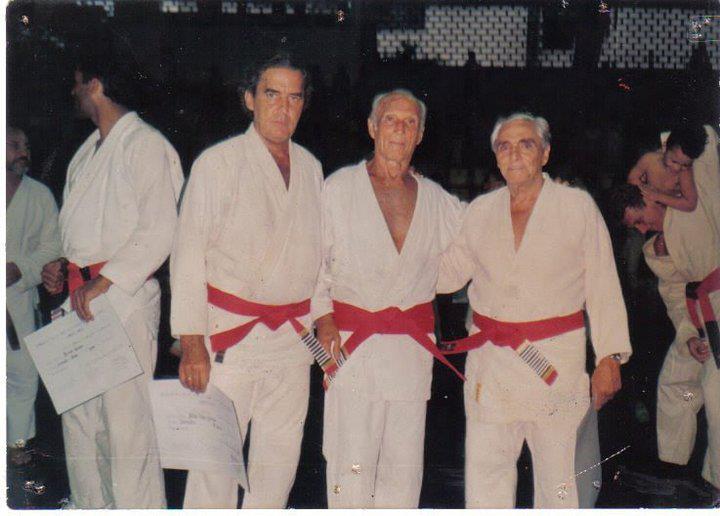
WT Gillespie
May 2014 I published my book about by sabbatical 15 mos 1997-98 training in Japan (after which I lived there another 7 years). One chapter in the epilogue is “Aikido Keiko in an MMA World”, which, among other things, explores the history of Japanese moving to Brasil near the turn of the century and bringing their martial arts with them. Good to see others exploring the topic with academic rigor.
People may enjoy this too, which another BJJ friend sent.
http://global-training-report.com/myths.htm
Regardless of the roots, I’m grateful I found good places to study newaza, thanks to Brasileiros. It’s enhanced my martial arts training but the evidence is that it’s Basically Japanese Judo.
Ellis Amdur
Mr. Gillespie – thanks for your note. I agree – and do not – with your last statement “the evidence is that it’s Basically Japanese Judo.” That this is true, on the one hand, is a given – looking at the chart, for one example, shows the incredible cross-fertilization and continuing influence. There was also significant cross-fertilization with wrestling in Europe, and the Americas (Maeda, in 1912,as we see in the article, presented ‘catch as catch can,’ to the Japanese). Beyond that, it is also clear that the ‘evidence’ is that aikido is basically Japanese jujutsu. There is not one aikido technique that one cannot find in older jujutsu schools. (and of course, directly from Daito-ryu). Yet aikido has something unique in character–and it’s not correct, I believe, to simply say that aikido is Daito-ryu. Similarly, BJJ is no longer judo–not only because of the other influences such as luta livre, for example – but because it has evolved into something unique. Something always comes from something. But often in the process, it becomes something with an identity of its own.
Steve Earle
William Gillespie (a friend) has done some interesting research on the relationship of Judo to BJJ. It appears in his book “Aikido in Japan.”
http://www.amazon.com/Aikido-Japan-Way-Less-Traveled/dp/0615950140/ref=sr_1_1?ie=UTF8&qid=1458647659&sr=8-1&keywords=aikido+in+japan